Introduction
Korea has actively engaged in marine ranching by installing artificial reefs in order to effectively utilize and manage marine resources in the nearby oceans, within the 200 nautical miles Exclusive Economic Zone, for monitoring coastal pollution and overfishing (Yoon et al., 2014). Korean marine ranching is practiced at Tongyoung, Yeosu, Uljin, Taean, and Jeju in five places (Hwang et al., 2012). The purpose of these marine ranches is to focus marine resources near artificial reefs, maximize production, provide breeding and living areas for marine organisms, and to preserve and nurture marine resources (Yoon et al., 2014, 2015). To utilize the artificial reefs effectively, it is important to constantly observe and evaluate the behavioral characteristics, spatio-temporal distribution, and biomass of fish in nearby artificial reefs (Oh et al., 2010; Yoon et al., 2011).
Recently, evaluations of marine resources occurring near artificial reefs have been conducted using fishing gear, underwater cameras, and hydroacoustics (Hwang et al., 2015; Kang et al., 2008; Lee et al., 2012; Oh et al., 2010; Yoon et al., 2015). Among these methods, using fishing gear is advantageous for determining the species composition of the marine resources, but limited by the requirement of long time to investigate data points for identifying distribution characteristics of fish over the entire nautical region. Diving and underwater camera might be hindered by environmental conditions, such as limitations of water depth and cloudiness of the water, as well as the native instinct of fish to flee when approached, which present difficulties in obtaining quantitative data (Hwang et al., 2004; Kang et al., 2008). However, hydroacoustics present the benefit of being able to access information over the entire nautical zone in a short period and enable the identification of artificial reefs. It is an effective method of conducting research on the effects of artificial reefs.
Research on artificial reefs using hydroacoustics involve transect and stationary methods. The transect method was used to identify the density, grouping effects, behavioral patterns, and three-dimensional visualization of the state of the artificial reef, including material and size (Hwang et al., 2004; Kang et al., 2008, 2011a, 2011b; Kim et al., 2011). The stationary methods were used to measure the distribution and density of fish by installing digital cameras and echosounders, and periodic evaluation of marine resources present near the artificial reef by placing multiple echosounders on the artificial reefs (Akamatsu et al., 2003; Fabi & Sala, 2002; Sala et al., 2007).
The present study used hydroacoustics to evaluate the effects of installing artificial reefs effectively by designating the areas near the artificial reefs as the research transect, and studying the behavioral characteristics, distribution, and density of fish periodically.
Materials and Methods
The nautical zone, where the present research was carried out, is the area surrounding the artificial reefs installed in the coastal marine ranch in Uljin, East Sea. This area has been installed with various artificial reefs, such as octagonal box-type enforced reefs, two-stage cylindrical enforced reefs, and two-stage box-type enforced reefs (Yoon et al., 2015). Additionally, the southern coast, centered around Geoil-ri where marine ranching area is developed, has well-developed rocky formations, and the areas with low water depth, including Jiksan-ri and Gusan-ri, have a higher sediment content compared to other areas (Yoon et al., 2011). The transect line utilized was a parallel transect crossing east and west, and the total length was approximately 9 miles (Fig. 1).
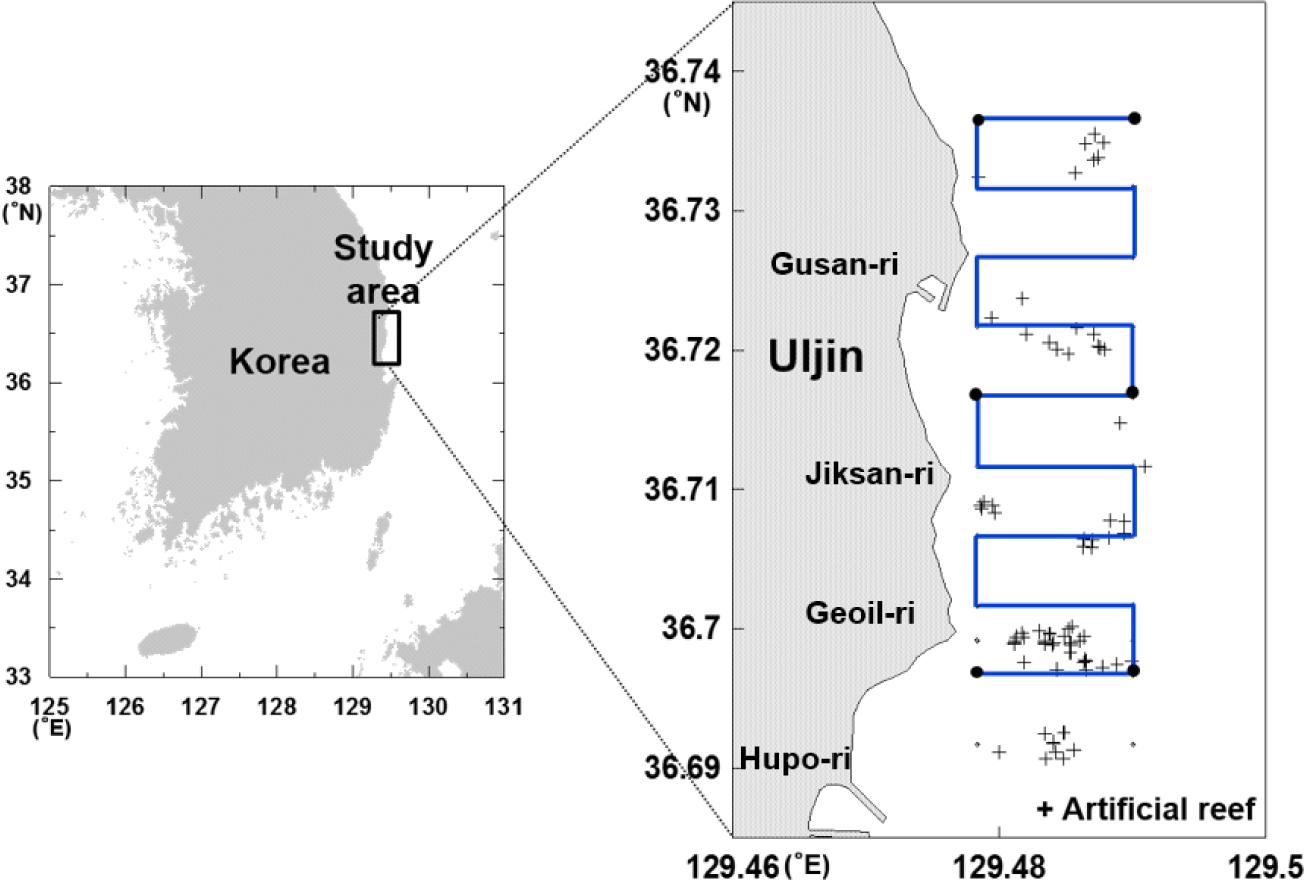
The present study was conducted from September 22–23, 2012, in the afternoon-sunset period (16:36–18:22 h, September 22), night (20:28–21:47 h, September 22) dawn-sunrise (05:51–07:20 h, September 23) and morning (07:22–08:46 h, September 23), and the same transect line was investigated. The sunset time at the research area was 18:19 h on September 22, and sunrise occurred at 06:11 h on September 23.
The acoustic system used in the present study was a dual-beam scientific echosounder with a frequency of 200 kHz (DT-5000, BioSonic, Seattle, WA, USA). The location data was continuously recorded by a Global positioning system (GPS) device (GP-50, Furuno, Nagasaki, Japan) and imported into the echosounder. The collected acoustic and location data were saved on a computer hard disk through the RS-232C interface.
The transeducer was fixed 1 m below the surface with a support on the side of the ship; the speed of the ship was maintained at approximately 5–7 knots, and the acoustic data was gathered at a pulse-length of 0.4 ms and pulse duration at 1 s. The acoustics data was gathered by using a separate power battery in order to avoid vibrations and miscellaneous sounds of the research vessel. Moreover, data on marine environment conditions (temperature and salinity) was collected using conductivity, temperature, and depth (CTD) device (miniCTD, Valeport, Totnes, UK) along the acoustic survey transect. Data was gathered from six transects on both sides of the transect line, from the surface to bottom (circles in Fig. 1).
The acoustics data collected were analyzed with acoustics data analytics software (Echoview ver. 4.7, Echoview Software, Hobart, Australia). All noises occurring at the surface were removed, and the echoes of fishes were separated using line selection method from underwater artificial reefs. The spatial distribution and density of fish was recorded within a distance of 0.1 n.mile. At each of the 5-m intervals of water depth from the surface, Elementary Distance Sampling Unit and density were expressed as Nautical Area Scattering Coefficients (NASC, m2/nmi2).
Results and Discussion
Water temperature over different periods ranged between 20.2°C–21.4°C, and the average temperature in each period were 20.8 ± 0.2°C at afternoon-sunset, 20.7 ± 0.1°C at night, 20.4 ± 0.1°C at dawn-sunrise, and 20.7 ± 0.4°C at morning periods, with no significant difference among periods. The salinity over the entire period ranged between 32.1–32.5 psu and the average salinity in afternoon-sunset, night, dawn-sunrise and morning periods were 32.4 ± 0.1, 32.3 ± 0.1, 32.4 ± 0.1, and 32.3 ± 0.1 psu, with no significant difference among the periods (Fig. 2).
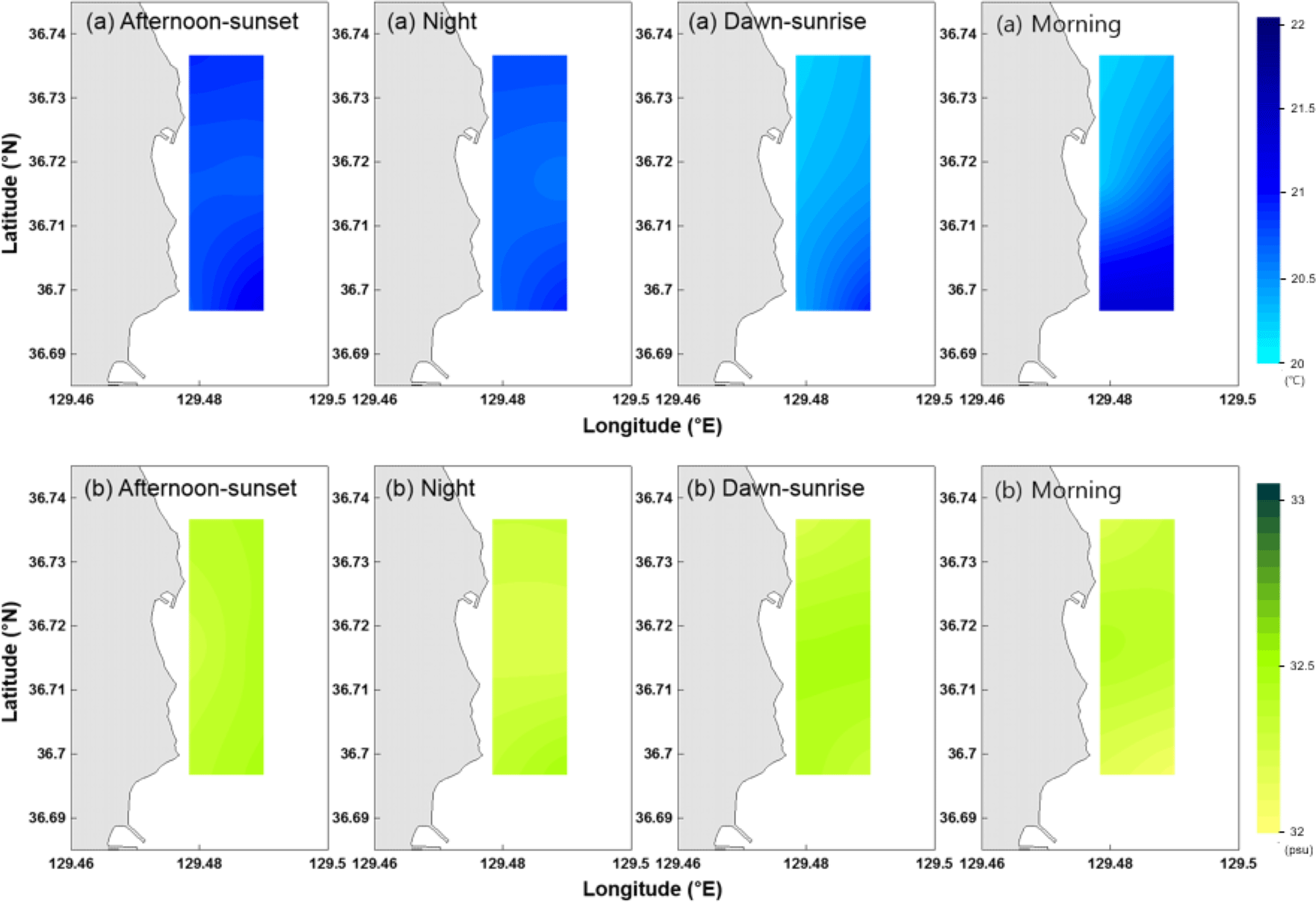
The echogram characteristics of fish near artificial reefs by period are shown in Fig. 3. In the afternoon-sunset period, small, low-layer fish groups were present near the artificial reefs (Fig. 3). At night, fish did not form groups, but remained individually. At dawn-sunrise, the fish formed groups again and were found near the upper layers of the artificial reef, the surface, and the middle-layer, and the morning period showed similar distributions. Thorne et al. (1989) conducted research of fish activity near the artificial reef and its surrounding areas similar to that of the present study, and found that fish formed strong clusters near the artificial reef and bottom layers in the afternoon, and showed extreme scattering away from the artificial reefs during dusk-night period. In dawn-sunrise periods, they found that the fish formed strong groups near and away from the artificial reefs. In a water tank filled with seawater (5 m × 5 m × 5 m), four artificial structures (1 m × 1 m × 1 m) were placed and fish activity, observed over 24 h from 10:00 h, indicated that the fish leave the artificial structures 2 h prior to sunset and approach the surface (Hwang et al., 2004). Moreover, it was observed that the fish surfaced within the artificial reefs, starting 30 minutes prior to sunset (Yoon et al., 2014).
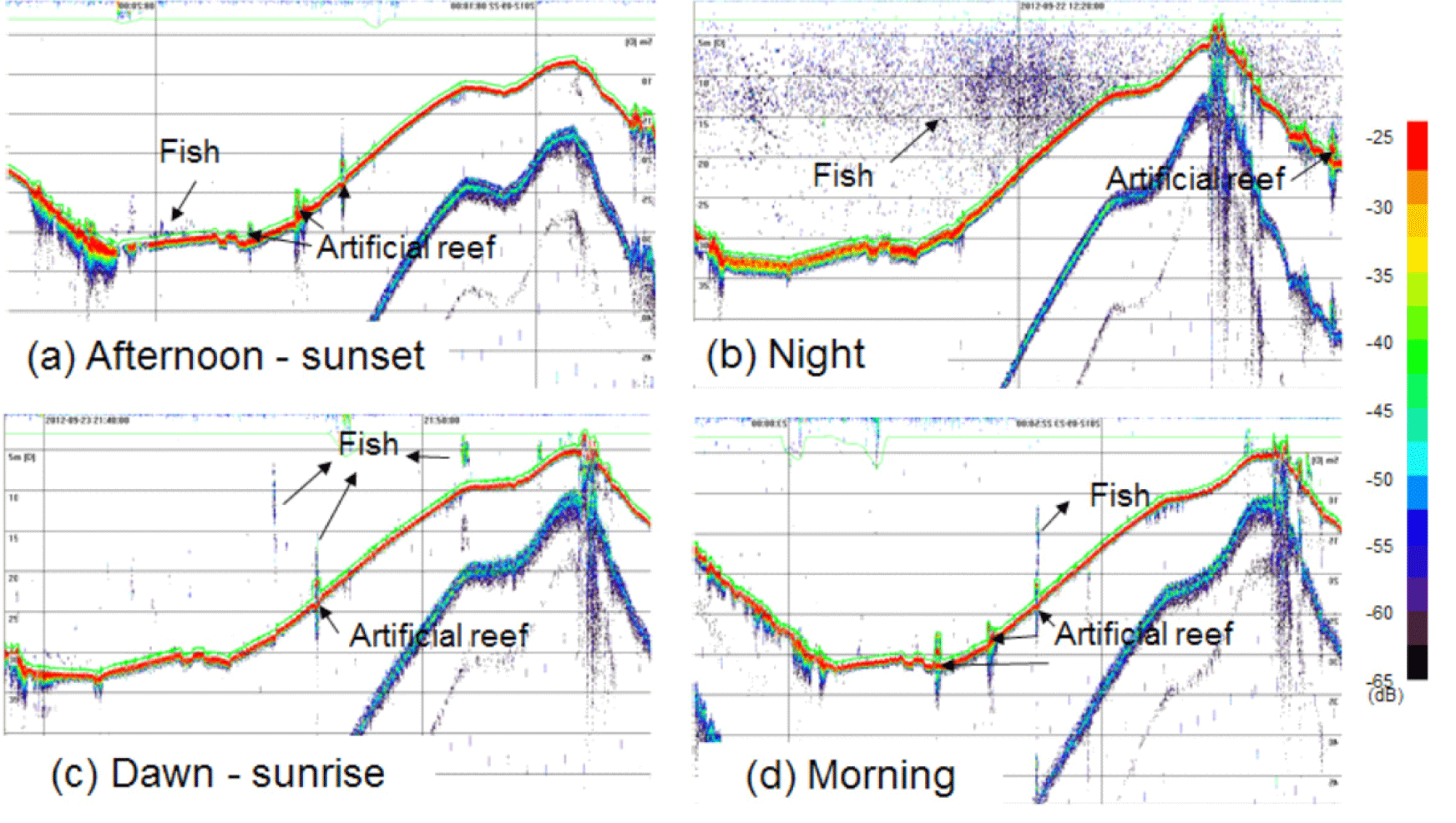
The spatial distribution of fish revealed significant differences among the different periods. Fish distribution was highest during dawn-sunrise; near the center of the research area, the density of fish was higher near the coast than in the open sea. Moreover, during dawn-sunrise, afternoon-sunset, and morning periods, fish were found in high densities near the coastal artificial reefs in the research area. However, the fish showed uniform distribution at similar densities in all the nautical zones (Fig. 4). This appears to be owing to the scattering of fish at night, and the grouping of fish during afternoon-sunset, dawn-sunrise, and morning periods, showing high densities in certain nautical zones. Also, during the night and dawn-sunrise periods, the density of fish school around artificial reefs was observed to be higher compared to other time periods. Fish near artificial reefs showed correlation with the characteristics of the artificial reef (material, size). Recently, several studies have analyzed fish distribution based on artificial reef characteristics using the geographic information system (GIS). In future, the GIS method is expected to clearly the relationship between temporal variation in fish distribution and artificial reef characteristics (Hamano et al., 2005; Kang et al., 2011a, 2011b).

The mean NASC value by integral time periods from the surface to the bottom water layers were the highest during dawn-sunrise at approximately 400.2 m2/nmi2, similar during night and morning periods at around 100.5 m2/nmi2, and the lowest during afternoon-sunset at 20.1 m2/nmi2 (Fig. 5).
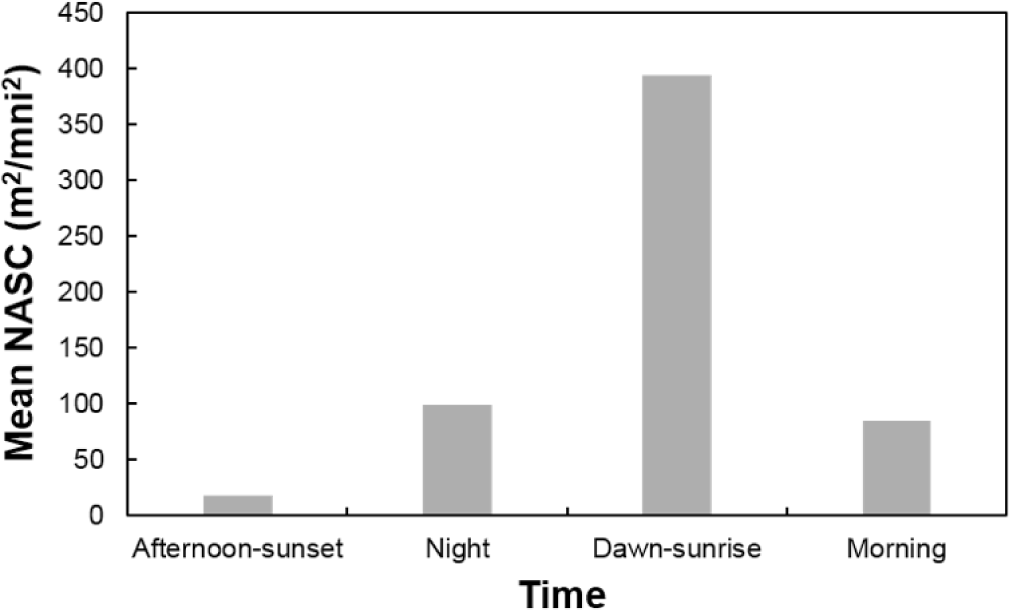
The mean NASC integrated at 5-m intervals of water depth were the highest at depths of approximately 20–25 m during afternoon-sunset period, and was high around the 10–15 m interval at night. Moreover, the mean NASC value at the 0–15 m surface layer was over 10 times higher than that in the deepest layer studied during dawn-sunrise. Further, during the morning period, density was high around the surface layer instead of the bottom layer, similar to dawn-sunrise periods (Fig. 6).
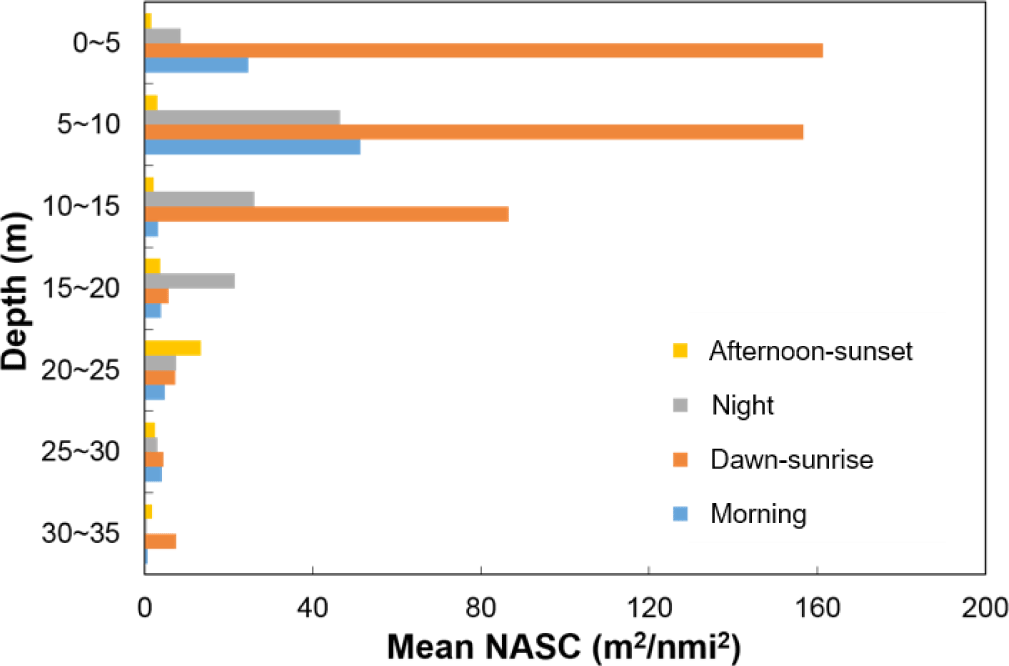
The echosounders were installed between the artificial reefs to measure and compare fish density over different periods. The results indicated that the highest fish density occurred during early morning and night. Fish stock and light intensity showed a negative correlation (Fabi & Sala, 2002). Moreover, the distribution of fish in the different layers over different periods indicated that the fish were at the bottom layer during night and early afternoon, and mainly around the surface or middle layers in the early morning periods (Sala et al., 2007).
In this study, although a fishing survey was not conducted, previous findings by Lee et al. (2018) reported results from a otter trawl survey conducted in the fall around Uljin. Dominant fish species identified in this region included Glyptocephalus stelleri, Cleisthenes pinetorum, Lophiomus setigerus, and Alcichthys elongatus (Lee et al., 2018). However, based on the results of this study, it is inferred that the density of fish in surface layer was high during the day, and many pelagic fish are detected.
Acoustic methods enable the identification of fish movement characteristics in a non-intrusive manner. However, it is difficult to identify species using the acoustic method. Using fishing gear or cameras in conjunction with the acoustic methods is expected to provide clarification on the behavioral characteristics of the different species.
Conclusion
The present study was conducted to evaluate the effects of artificial reef installation on marine fish effectively based on hydroacoustics, with the transect line set near the artificial reefs of Uljin marine ranch and observe the distribution and density of fish at different time periods. The water temperature ranged from 20.2°C–21.4°C and salinity ranged from 32.1–32.5 psu, with no major differences in temperature or salinity at different periods. During the afternoon-sunset period, the fish was distributed in small, bottom-layer groups near the artificial reef; at night, the fish did not form groups and were scattered. During dawn-sunrise and morning, the fish formed groups and were found in the upper layer, surface, and middle layers of the artificial reefs. The spatial distribution of fish was such that during afternoon-sunset, dawn-sunrise, and morning, they were found in high densities near the center of the research zone, where the artificial reef was installed; at night, the fish showed uniform distribution, with similar densities over the entire area. Moreover, the mean NASC value by period was highest during dawn-sunrise, and lowest at afternoon-sunset.








